The Effects of Potato Presentation on Vegetable Intake in School-Aged Children: A Cross-Over Study
Abstract
:1. Introduction
2. Materials and Methods
2.1. Study Design
2.2. Participants
2.3. Meal Conditions
2.4. Procedures
2.5. Measurements
2.5.1. Demographics, Body Height, Weight, and Composition
2.5.2. Skin Carotenoids
2.5.3. Hand Grip Strength
2.5.4. Fullness and Likeability
2.5.5. Plate Waste
2.6. Power and Statistical Analysis
3. Results
4. Discussion
5. Conclusions
Author Contributions
Funding
Institutional Review Board Statement
Informed Consent Statement
Data Availability Statement
Acknowledgments
Conflicts of Interest
References
- Centers for Disease Control and Prevention. Heart Disease Facts. 2022. Available online: https://www.cdc.gov/heartdisease/facts.htm (accessed on 22 February 2022).
- Heidemann, C.; Schulze, M.B.; Franco, O.H.; van Dam, R.M.; Mantzoros, C.S.; Hu, F.B. Dietary Patterns and Risk of Mortality From Cardiovascular Disease, Cancer, and All Causes in a Prospective Cohort of Women. Circulation 2008, 118, 230–237. [Google Scholar] [CrossRef]
- Kushi, L.H.; Lew, R.A.; Stare, F.J.; Ellison, C.R.; El Lozy, M.; Bourke, G.; Daly, L.; Graham, I.; Hickey, N.; Mulcahy, R.; et al. Diet and 20-year mortality from coronary heart disease: The Ireland-Boston diet-heart study. N. Engl. J. Med. 1985, 312, 811–818. [Google Scholar] [CrossRef]
- Mann, J.I. Diet and risk of coronary heart disease and type 2 diabetes. Lancet 2002, 360, 783–789. [Google Scholar] [CrossRef] [PubMed]
- Odermatt, A. The Western-style diet: A major risk factor for impaired kidney function and chronic kidney disease. Am. J. Physiol.-Ren. Physiol. 2011, 301, 919–931. [Google Scholar] [CrossRef]
- Stampfer, M.J.; Hu, F.B.; Manson, J.E.; Rimm, E.B.; Willett, W.C. Primary Prevention of Coronary Heart Disease in Women through Diet and Lifestyle. N. Engl. J. Med. 2000, 343, 16–22. [Google Scholar] [CrossRef]
- Hayhoe, R.; Rechel, B.; Clark, A.B.; Gummerson, C.; Smith, S.L.; Welch, A.A. Cross-sectional associations of schoolchildren’s fruit and vegetable consumption, and meal choices, with their mental well-being: A cross-sectional study. BMJ Nutr. Prev. Health 2021, 4, 447–462. [Google Scholar] [CrossRef] [PubMed]
- Anderson-Villaluz, D. Giving Children and Adolescents a Healthy Start through Nutrition. 2021. Available online: https://health.gov/news/202103/giving-children-and-adolescents-healthy-start-through-nutrition (accessed on 12 May 2022).
- Schwartz, C.; Scholtens, P.A.; Lalanne, A.; Weenen, H.; Nicklaus, S. Development of healthy eating habits early in life. Review of recent evidence and selected guidelines. Appetite 2011, 57, 796–807. [Google Scholar] [CrossRef]
- Cena, H.; Calder, P.C. Defining a Healthy Diet: Evidence for the Role of Contemporary Dietary Patterns in Health and Disease. Nutrients 2020, 12, 334. [Google Scholar] [CrossRef] [PubMed]
- United States Department of Agriculture; U.S. Department of Health and Human Services. Dietary Guidelines for Americans, 2020–2025, 9th ed.; United States Department of Agriculture; U.S. Department of Health and Human Services: Washington, DC, USA, 2020. Available online: https://dietaryguidelines.gov/ (accessed on 14 May 2022).
- U.S. Department of Agriculture. Food and Nutrition Services, National School Lunch Program Meal Pattern Chart; U.S. Department of Agriculture: Washington, DC, USA, 2020. Available online: https://www.fns.usda.gov/nslp/national-school-lunch-program-meal-pattern-chart (accessed on 8 January 2022).
- Kim, S.A.; Moore, L.V.; Galuska, D.; Wright, A.P.; Harris, D.; Grummer-Strawn, L.M.; Merlo, C.L.; Nihiser, A.J.; Rhodes, D.G. Vital Signs. MMWR. Morb. Mortal. Wkly. Rep. 2014, 63, 671–676. [Google Scholar] [PubMed]
- Wambogo, E.A.; Ansai, N.; Ahluwalia, N.; Ogden, C.L. Fruit and Vegetable Consumption among Children and Adolescents in the United States, 2015–2018; NCHS Data Brief; National Center for Health Statistics: Hyattsville, MD, USA, 2020; pp. 1–8. [Google Scholar]
- Chawner, L.R.; Hetherington, M.M. Utilizing an integrated approach to developing liking for and consumption of vegetables in children. Physiol. Behav. 2021, 238, 113493. [Google Scholar] [CrossRef]
- McGlone, K.; Banna, J. A Unique, Innovative, Easy-to-Use Program to Improve Young Children’s Attitudes About and Consumption of Fruits and Vegetables. Am. J. Lifestyle Med. 2020, 14, 24–27. [Google Scholar] [CrossRef] [PubMed]
- Miller, G.F.; Gupta, S.; Kropp, J.D.; Grogan, K.A.; Mathews, A. The effects of pre-ordering and behavioral nudges on National School Lunch Program participants’ food item selection. J. Econ. Psychol. 2016, 55, 4–16. [Google Scholar] [CrossRef]
- Ahern, S.M.; Caton, S.J.; Blundell-Birtill, P.; Hetherington, M.M. The effects of repeated exposure and variety on vegetable intake in pre-school children. Appetite 2019, 132, 37–43. [Google Scholar] [CrossRef] [PubMed]
- Diktas, H.E.; Roe, L.S.; Keller, K.L.; Sanchez, C.E.; Rolls, B.J. Promoting vegetable intake in preschool children: Independent and combined effects of portion size and flavor enhancement. Appetite 2021, 164, 105250. [Google Scholar] [CrossRef]
- Roe, L.S.; Sanchez, C.E.; Smethers, A.D.; Keller, K.L.; Rolls, B.J. Portion size can be used strategically to increase intake of vegetables and fruits in young children over multiple days: A cluster-randomized crossover trial. Am. J. Clin. Nutr. 2022, 115, 272–283. [Google Scholar] [CrossRef]
- Olsen, A.; Ritz, C.; Kraaij, L.W.; Møller, P. Children’s liking and intake of vegetables: A school-based intervention study. Food Qual. Prefer. 2012, 23, 90–98. [Google Scholar] [CrossRef]
- Just, D.R.; Lund, J.; Price, J. The Role of Variety in Increasing the Consumption of Fruits and Vegetables among Children. Agric. Resour. Econ. Rev. 2012, 41, 72–81. [Google Scholar] [CrossRef]
- Hakim, S.M.; Meissen, G. Increasing consumption of fruits and vegetables in the school cafeteria: The influence of active choice. J. Health Care Poor Underserved 2013, 24 (Suppl. S2), 145–157. [Google Scholar] [CrossRef] [PubMed]
- Correia, D.C.; O’Connell, M.; Irwin, M.L.; Henderson, K.E. Pairing vegetables with a liked food and visually appealing presentation: Promising strategies for increasing vegetable consumption among preschoolers. Child. Obes. 2014, 10, 72–76. [Google Scholar] [CrossRef]
- Au, L.E.; Gurzo, K.; Gosliner, W.; Webb, K.L.; Crawford, P.B.; Ritchie, L.D. Eating School Meals Daily Is Associated with Healthier Dietary Intakes: The Healthy Communities Study. J. Acad. Nutr. Diet. 2018, 118, 1474–1481.e1. [Google Scholar] [CrossRef] [PubMed]
- Cullen, K.W.; Chen, T.-A. The contribution of the USDA school breakfast and lunch program meals to student daily dietary intake. Prev. Med. Rep. 2017, 5, 82–85. [Google Scholar] [CrossRef]
- Story, M.; Miller, L.; Lott, M. The School Nutrition and Meal Cost Study-I: Overview of Findings Related to Improving Diet Quality, Weight, and Disparities in US Children and Policy Implications. Nutrients 2021, 13, 1357. [Google Scholar] [CrossRef] [PubMed]
- Adams, E.L.; Raynor, H.A.; Thornton, L.M.; Mazzeo, S.E.; Bean, M.K. Nutrient intake during school lunch in title I elementary schools with universal free meals. Health education & behavior. Health Educ. Behav. 2022, 49, 118–127. [Google Scholar] [PubMed]
- Ralsoton, K.; Newman, C.; Clauson, A.L.; Guthrie, J.; Buzby, J. The National School Lunch Program: Background, Trends, and Issues; Economic Research Report; United States Department of Agriculture: Washington, DC, USA, 2008. [Google Scholar]
- Food and Nutrition Services. USDA Unveils Historic Improvements to Meals Served in America’s Schools, 12th ed.; USDA 0023; Food and Nutrition Service U.S. Department of Education: Washington, DC, USA, 2012. [Google Scholar]
- Food and Nutrition Services. Nutrition standards in the National School Lunch and School Breakfast Programs. Final rule. Fed. Regist. 2012, 77, 4088–4167. Available online: https://www.ncbi.nlm.nih.gov/pubmed/22359796 (accessed on 8 January 2022).
- Cohen, J.F.W.; Richardson, S.; Parker, E.; Catalano, P.J.; Rimm, E.B. Impact of the New U.S. Department of Agriculture School Meal Standards on Food Selection, Consumption, and Waste. Am. J. Prev. Med. 2014, 46, 388–394. [Google Scholar] [CrossRef]
- Chaudhary, A.; Sudzina, F.; Mikkelsen, B.E. Promoting Healthy Eating among Young People—A Review of the Evidence of the Impact of School-Based Interventions. Nutrients 2020, 12, 2894. [Google Scholar] [CrossRef]
- United States Department of Agriculture. Potatoes and Tomatoes Are the Most Commonly Consumed Vegetables; United States Department of Agriculture: Washington, DC, USA, 2020. Available online: https://www.ers.usda.gov/data-products/chart-gallery/gallery/chart-detail/?chartId=58340 (accessed on 8 January 2022).
- Drewnowski, A.; Rehm, C.D. Vegetable cost metrics show that potatoes and beans provide most nutrients per penny. PLoS ONE 2013, 8, e63277. [Google Scholar] [CrossRef] [PubMed]
- Handforth, K.M.; Gilboy, M.B.; Harris, J.; Melia, N. Fruit and Vegetable Plate Waste among Students in a Suburban School District Participating in the National School Lunch Program. J. Child Nutr. Manag. 2016, 40, 1–12. [Google Scholar]
- Kuczmarski, R.J.; Ogden, C.L.; Guo, S.S.; Grummer-Strawn, L.M.; Flegal, K.M.; Mei, Z.; Wei, R.; Curtin, L.R.; Roche, A.F.; Johnson, C.L. CDC Growth Charts: United States; U.S. Department of Health and Human Services, Centers for Disease Control and Prevention, National Center for Health Statistics: Washington, DC, USA, 2000; pp. 1–27. [Google Scholar]
- Ogden, C.L.; Li, Y.; Freedman, D.S.; Borrud, L.G.; Flegal, K.M. Smoothed Percentage Body Fat Percentiles for U.S. Children and Adolescents, 1999–2004; CDC: Atlanta, GA, USA, 2011; pp. 1–7. [Google Scholar]
- Jahns, L.; Johnson, L.K.; Conrad, Z.; Bukowski, M.; Raatz, S.K.; Jilcott Pitts, S.; Wang, Y.; Ermakov, I.V.; Gellermann, W. Concurrent validity of skin carotenoid status as a concentration biomarker of vegetable and fruit intake compared to multiple 24-h recalls and plasma carotenoid concentrations across one year: A cohort study. Nutr. J. 2019, 18, 78. [Google Scholar] [CrossRef]
- Ermakov, I.V.; Ermakova, M.; Sharifzadeh, M.; Gorusupudi, A.; Farnsworth, K.; Bernstein, P.S.; Stookey, J.; Evans, J.; Arana, T.; Tao-Lew, L.; et al. Optical assessment of skin carotenoid status as a biomarker of vegetable and fruit intake. Arch. Biochem. Biophys. 2018, 646, 46–54. [Google Scholar] [CrossRef] [PubMed]
- Whigham, L.; Redelfs, A. Inter-finger Variability and Other Influencing Factors for Using Reflectance Spectroscopy for Skin Carotenoid Detection. FASEB J. 2016, 30, 409.2. [Google Scholar]
- Radtke, M.D.; Poe, M.; Stookey, J.; Jilcott Pitts, S.; Moran, N.E.; Landry, M.J.; Rubin, L.P.; Stage, V.C.; Scherr, R.E. Recommendations for the Use of the Veggie Meter® for Spectroscopy-Based Skin Carotenoid Measurements in the Research Setting. Curr. Dev. Nutr. 2021, 5, nzab104. [Google Scholar] [CrossRef]
- MacDermid, J.; Solomon, G.; Valdes, K. Clinical Assessment Recommendations, 3rd ed.; Mount Laurel, N.J., Ed.; American Society of Hand Therapists: Mount Laurel, NJ, USA, 2015. [Google Scholar]
- Keller, K.L.; Assur, S.A.; Torres, M.; Lofink, H.E.; Thornton, J.C.; Faith, M.S.; Kissileff, H.R. Potential of an analog scaling device for measuring fullness in children: Development and preliminary testing. Appetite 2006, 47, 233–243. [Google Scholar] [CrossRef] [PubMed]
- Chapman, L.E.; Richardson, S.; McLeod, L.; Rimm, E.; Cohen, J. Pilot Evaluation of Aggregate Plate Waste as a Measure of Students’ School Lunch Consumption. J. Acad. Nutr. Diet. 2019, 119, 2093–2098. [Google Scholar] [CrossRef] [PubMed]
- Razalli, N.H.; Cheah, C.F.; Mohammad, N.M.A.; Manaf, Z.A. Plate waste study among hospitalised patients receiving texture-modified diet. Nutr. Res. Pract. 2021, 15, 655–671. [Google Scholar] [CrossRef]
- Kurek, M.; Wyrwisz, J.; Piwińska, M.; Wierzbicka, A. The Effect of Oat Fibre Powder Particle Size on the Physical Properties of Wheat Bread Rolls. Food Technol. Biotechnol. 2016, 54, 45–51. [Google Scholar] [CrossRef]
- Ferrão, L.L.; Ferreira, M.V.S.; Cavalcanti, R.N.; Carvalho, A.F.A.; Pimentel, T.C.; Silva, H.L.; Silva, R.; Esmerino, E.A.; Neto, R.P.; Tavares, M.I.B.; et al. The xylooligosaccharide addition and sodium reduction in requeijão cremoso processed cheese. Food Res. Int. 2018, 107, 137–147. [Google Scholar] [CrossRef]
- King, J.C.; Slavin, J.L. White Potatoes, Human Health, and Dietary Guidance. Adv. Nutr. 2013, 4, 393S–401S. [Google Scholar] [CrossRef] [PubMed]
- D’Adamo, C.R.; Parker, E.A.; McArdle, P.F.; Trilling, A.; Bowden, B.; Bahr-Robertson, M.K.; Keller, K.L.; Berman, B.M. The addition of spices and herbs to vegetables in the National School Lunch Program increased vegetable intake at an urban, economically-underserved, and predominantly African-American high school. Food Qual. Prefer. 2021, 88, 104076. [Google Scholar] [CrossRef] [PubMed]
- Akilen, R.; Deljoomanesh, N.; Hunschede, S.; Smith, C.E.; Arshad, M.U.; Kubant, R.; Anderson, G.H. The effects of potatoes and other carbohydrate side dishes consumed with meat on food intake, glycemia and satiety response in children. Nutr. Diabetes 2016, 6, e195. [Google Scholar] [CrossRef]
- Hanson, J.; Elmore, J.; Swaney-Stueve, M. Food Trying and Liking Related to Grade Level and Meal Participation. Int. J. Environ. Res. Public Health 2020, 17, 5641. [Google Scholar] [CrossRef]
- Cooke, L. The importance of exposure for healthy eating in childhood: A review. J. Hum. Nutr. Diet. 2007, 20, 294–301. [Google Scholar] [CrossRef] [PubMed]
- Chapman, L.E.; Cohen, J.; Canterberry, M.; Carton, T.W. Factors Associated with School Lunch Consumption: Reverse Recess and School “Brunch”. J. Acad. Nutr. Diet. 2017, 117, 1413–1418. [Google Scholar] [CrossRef] [PubMed]
- Prescott, M.P.; Gilbride, J.A.; Corcoran, S.P.; Elbel, B.; Woolf, K.; Ofori, R.O.; Schwartz, A.E. The Relationship between School Infrastructure and School Nutrition Program Participation and Policies in New York City. Int. J. Environ. Res. Public Health 2022, 19, 9649. [Google Scholar] [CrossRef] [PubMed]
- Ang, I.Y.H.; Wolf, R.L.; Koch, P.A.; Gray, H.L.; Trent, R.; Tipton, E.; Contento, I.R. School Lunch Environmental Factors Impacting Fruit and Vegetable Consumption. J. Nutr. Educ. Behav. 2019, 51, 68–79. [Google Scholar] [CrossRef] [PubMed]
- Wengreen, H.J.; Joyner, D.; Kimball, S.S.; Schwartz, S.; Madden, G.J. A Randomized Controlled Trial Evaluating the FIT Game’s Efficacy in Increasing Fruit and Vegetable Consumption. Nutrients 2021, 13, 2646. [Google Scholar] [CrossRef] [PubMed]
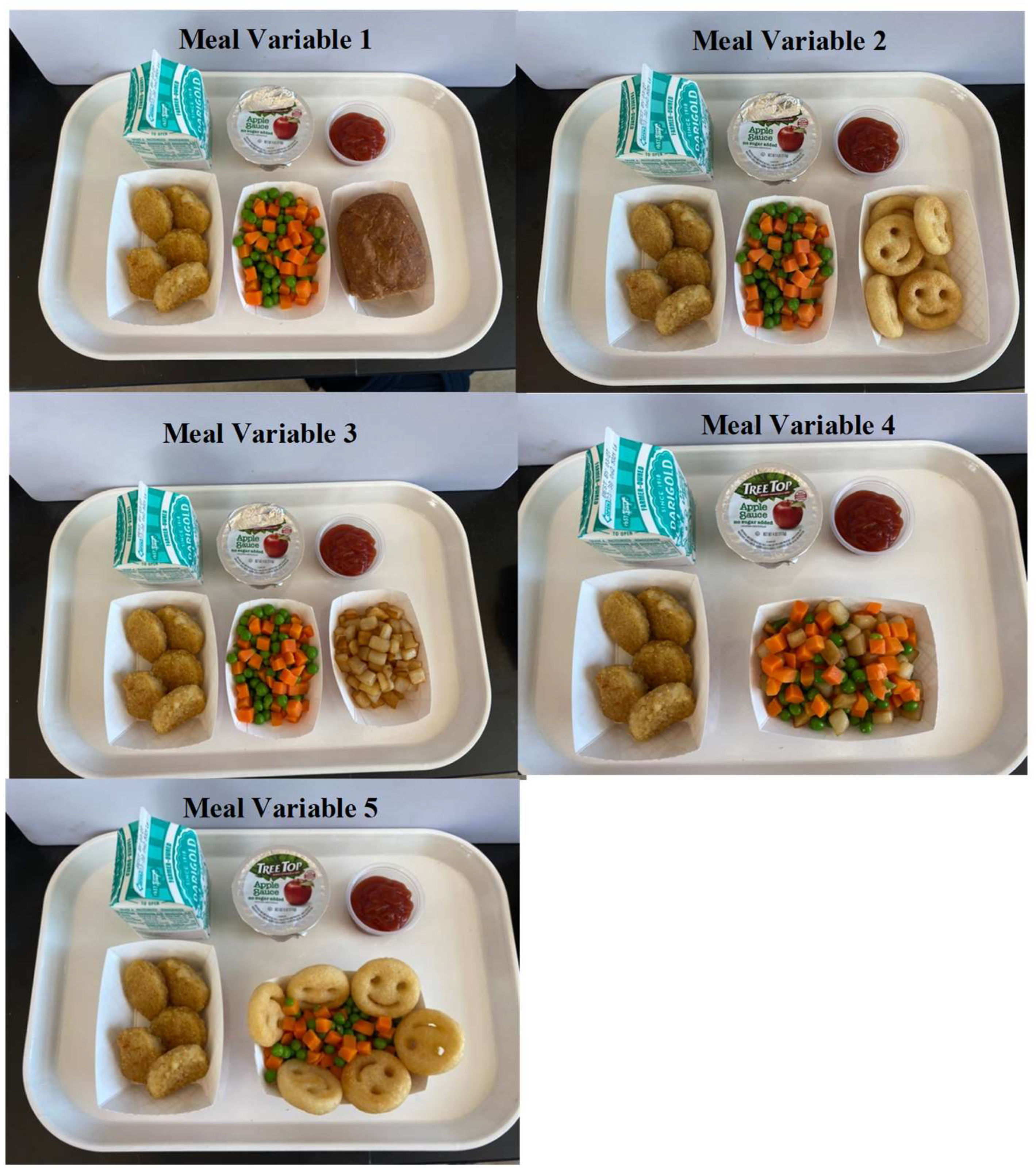
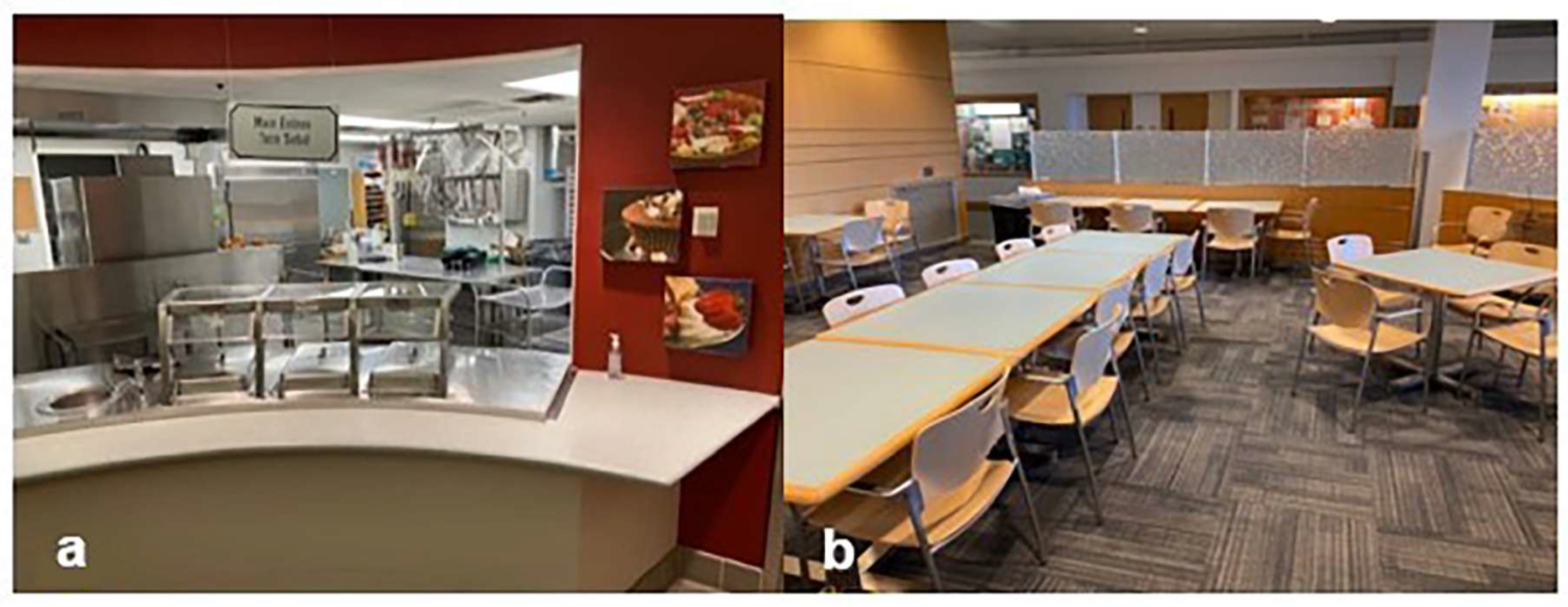
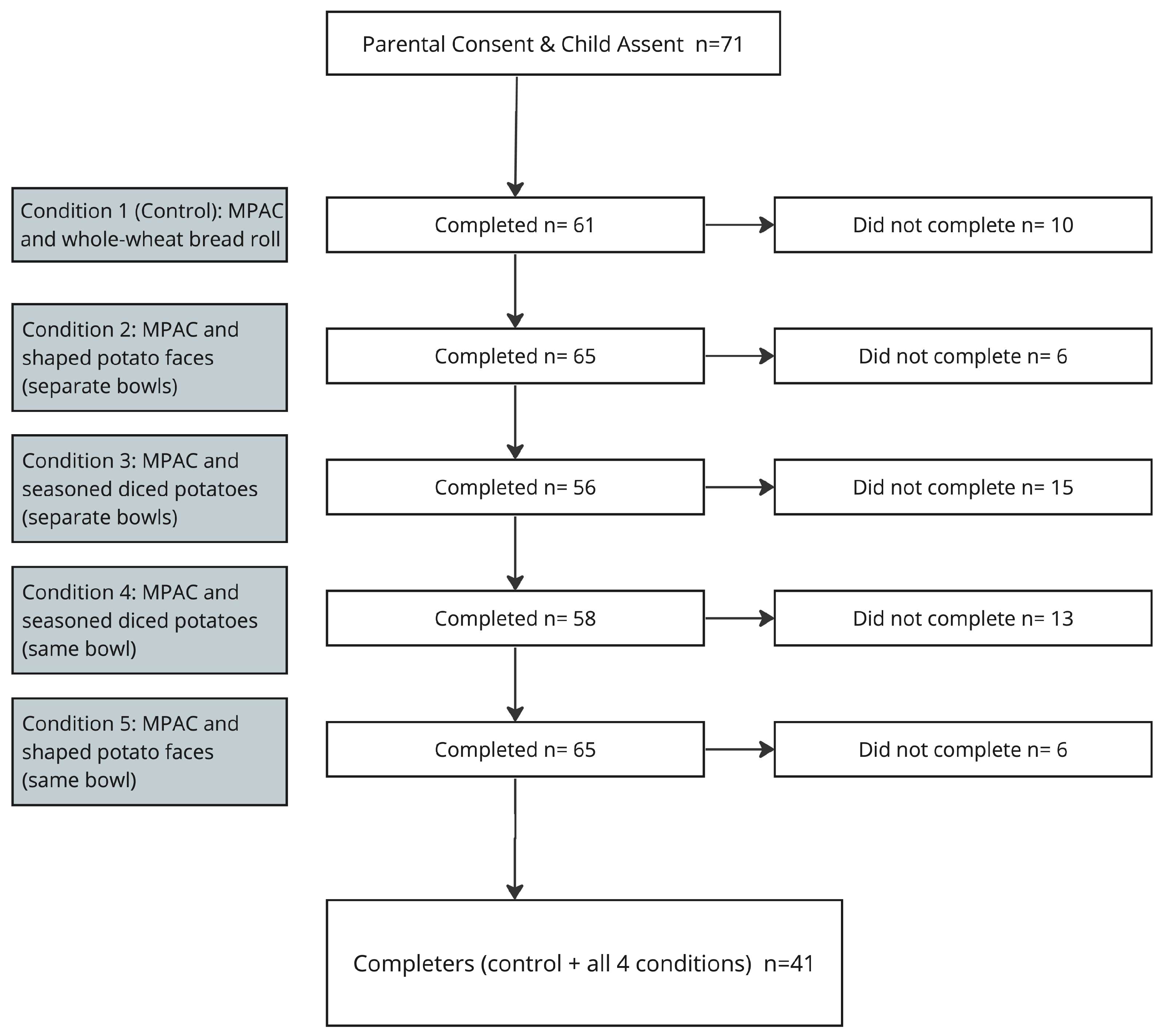
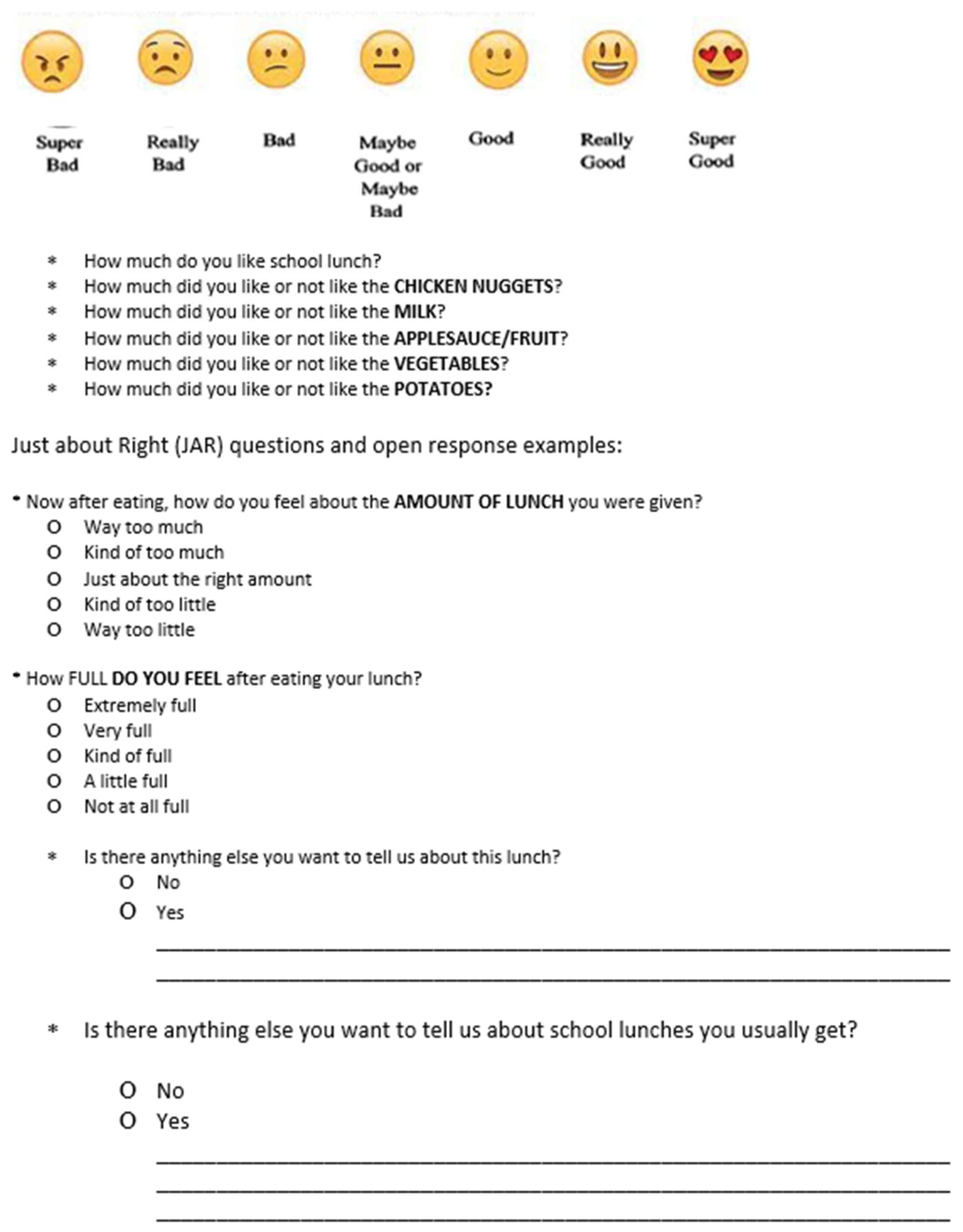
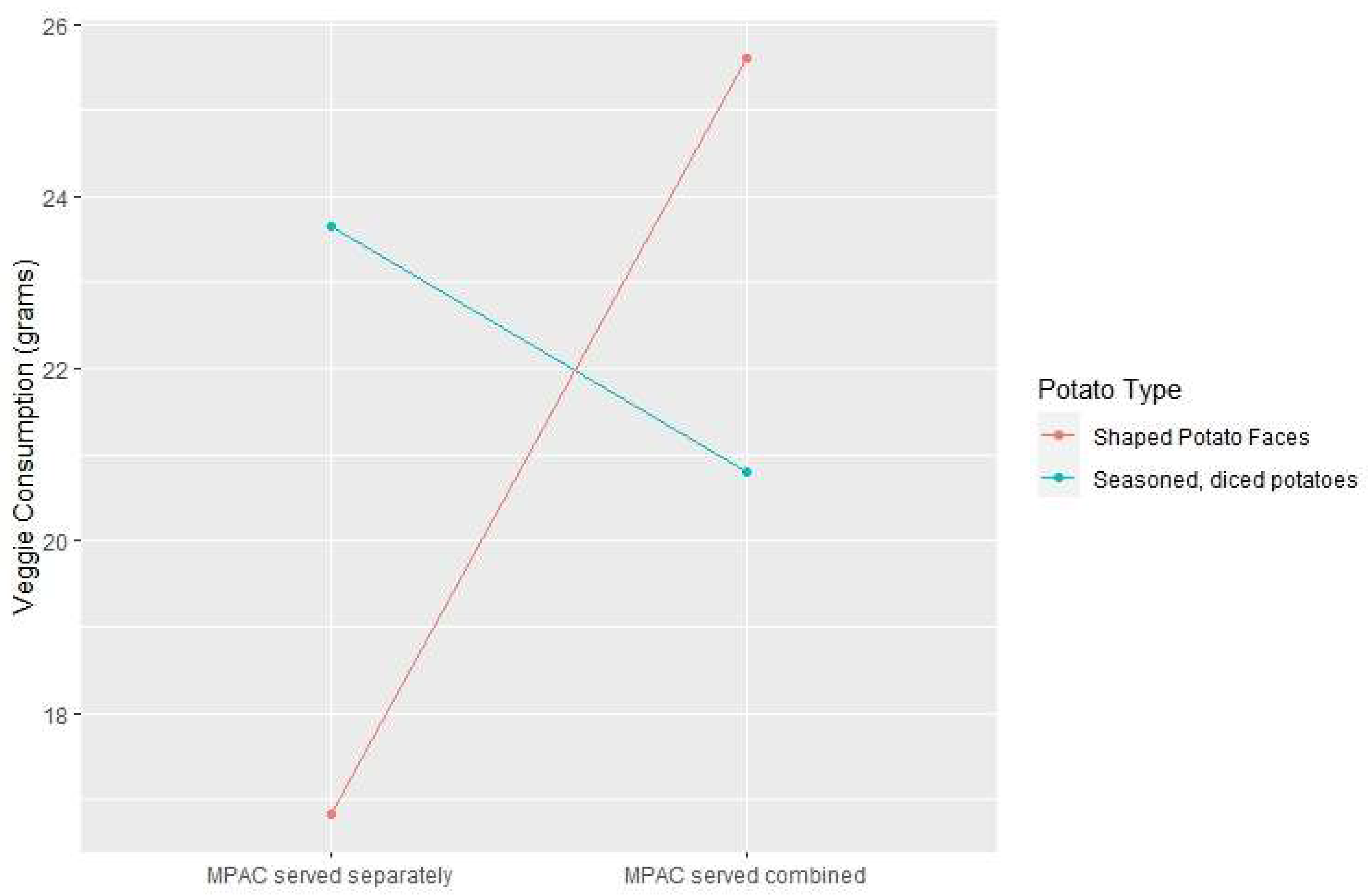
| Meal Nutrients | |||||||
|---|---|---|---|---|---|---|---|
| Peas/Carrots Mix (Seasoned) a | Whole Wheat Roll | Shaped Potato Face | Seasoned Diced Potatoes b | 1% Milk | Chicken Nuggets | Apple Sauce | |
| Amount (g) | 85 | 40 | 85 | 85 | 260 | 100 | 110 |
| Calories | 54 | 110 | 160 | 75 | 110 | 250 | 60 |
| Protein (g) | 2.9 | 4 | 2 | 2 | 8 | 13 | 1 |
| Carbohydrates (g) | 9.5 | 17 | 22 | 15 | 13 | 14 | 15 |
| Fiber (g) | 2.9 | 3 | 2 | 1.2 | 0 | 0.8 | 3 |
| Total Fat (g) | 1.1 | 1.5 | 8 | 1.5 | 2.5 | 16 | 0 |
| Sat Fat (g) | 0.2 | 0 | 1 | 0.2 | 1.5 | 3 | 0 |
| Sodium (mg) | 147 | 190 | 170 | 158 | 130 | 630 | 0 |
| Potassium (mcg) | 165 | 109 | 310 | 360 | 400 | 160 | 116 |
| Total (n = 65) | Girls (n = 28) | Boys (n = 37) | T-Statistic (Girls vs. Boys) | p-Value | |
|---|---|---|---|---|---|
| Age | 9.8 ± 2.06 | 9.5 ± 2.05 | 9.9 ± 2.08 | −0.86 | 0.3921 |
| Weight (kg) | 37.1 ± 11.9 | 34.1 ± 10.9 | 39.3 ± 14.6 | −1.60 | 0.1157 |
| Height (m) | 1.43 ± 0.16 | 1.41 ± 0.15 | 1.45 ± 0.16 | −1.06 | 0.2925 |
| Weight z-score | 0.42 ± 1.00 | 0.18 ± 0.86 | 0.60 ± 1.08 | −1.68 | 0.0987 |
| Body fat (%) | 18.4 ± 5.79 | 19.9 ± 5.51 | 17.3 ± 5.82 | 1.79 | 0.0779 |
| BMI (kg/m2) | 17.5 ± 2.93 | 16.8 ± 2.31 | 18.1 ± 3.24 | −1.80 | 0.0769 |
| Hand grip Z-score | −0.58 ± 0.89 | −0.61 ± 0.88 | −0.55 ± 0.92 | −0.27 | 0.7890 |
| BMI z-score | 0.08 ± 1.04 | −0.15 ± 0.95 | 0.25 ± 1.08 | −1.57 | 0.1212 |
| Grip strength (kg) | 14.11 ± 5.21 | 13.18 ± 5.42 | 14.81 ± 5.01 | −1.25 | 0.2162 |
| Fullness (pre-meal) | 5.02 ± 2.64 | 4.83 ± 2.69 | 5.17 ± 2.63 | −0.51 | 0.6120 |
| Fullness (post-meal) | 11.27 ± 1.04 | 11.85 ± 2.88 | 10.84 ± 2.26 | 1.59 | 0.1176 |
| Fullness (difference) | 0.08 ± 1.04 | 7.02 ± 3.05 | 5.67 ± 2.65 | 1.91 | 0.0613 |
| Nutrient Consumption | Control (Roll) | Shaped Potato Faces Served Separately | Diced Potatoes Served Separately | Dice Potatoes Served Combined | Shaped Potato Faces Served Combined | F | p |
|---|---|---|---|---|---|---|---|
| MPACs (g) | 21.1 ± 30.4 | 16.8 ± 27.5 | 23.6 ± 28.2 | 20.8 ± 27.8 | 25.6 ± 27.6 | 5.20 | 0.0005 |
| MPACs (kcal) | 13.4 ± 19.3 | 10.7 ± 17.5 | 15.0 ± 17.9 | 13.2 ± 17.7 | 16.3 ± 17.5 | ||
| Nutrient Consumption Amount (g) | 355 ± 151 | 354 ±153 | 345 ± 159 | 361 ± 155 | 377 ± 148 | 2.52 | 0.0418 |
| Calories (kcal) | 414 ± 107 | 432 ± 122 | 366 ± 103 | 374 ± 102 | 452 ± 115 | 28.25 | <0.0001 |
| Protein (g) | 20.2 ± 5.6 | 17.7 ± 5.6 | 17.9 ± 5.4 | 18.4 ± 5.3 | 18.8 ± 5.2 | 10.10 | <0.0001 |
| Carbohydrate (g) | 44.0 ± 14.9 | 45.7 ± 15.5 | 38.5 ± 14.9 | 39.4 ± 14.7 | 47.9 ± 15.2 | 20.51 | <0.0001 |
| Fiber (g) | 5.7 ± 2.4 | 4.7 ± 2.1 | 4.2 ± 1.9 | 4.1 ± 1.9 | 5.0 ± 2.1 | 23.76 | <0.0001 |
| Total Fat (g) | 17.1 ± 3.2 | 21.0 ± 5.2 | 16.6 ± 3.7 | 16.8 ± 3.5 | 21.8 ± 4.8 | 60.77 | <0.0001 |
| Saturated Fat (g) | 3.6 ± 0.8 | 4.0 ± 1.1 | 3.5 ± 0.9 | 3.6 ± 0.9 | 4.2 ± 1.1 | 24.87 | <0.0001 |
| Sodium (mg) | 791 ± 175 | 748 ± 192 | 727 ± 185 | 739 ± 173 | 785 ± 173 | 5.07 | 0.0006 |
| Potassium (mcg) | 477 ± 206 | 651 ± 265 | 616 ± 312 | 646 ± 294 | 695 ± 254 | 31.38 | <0.0001 |
| Overall Condition Effect | Potatoes Minus Roll | Comb. Minus Separate | Shaped Potato Faces Minus Diced | Potato Type by Combination Status Interaction Effect | |
|---|---|---|---|---|---|
| MPACs (g) p-value | (p = 0.0005) | 0.60 g (p = 0.7100) | 2.96 g (p = 0.0422) | −1.01 g (p = 0.4879) | 11.62 g (p < 0.0001) |
| MPACs (kcal) p-value | (p = 0.0005) | 0.38 kcal (p = 0.7100) | 1.88 kcal (p = 0.0422) | −0.64 kcal (p = 0.4879) | 7.38 kcal (p < 0.0001) |
| Nutrient Consumption Amount (g) | (p = 0.0418) | 4.38 g (p = 0.6066) | 19.83 g (p = 0.0097) | 12.67 g (p = 0.0972) | 7.48 g (p = 0.6233) |
| Calories (kcal) | (p < 0.0001) | −8.11 kcal (0.2988) | 13.76 kcal (p = 0.0491) | 72.13 kcal (p < 0.0001) | 11.60 kcal (p = 0.4057) |
| Protein (g) | (p < 0.0001) | −2.01 g (p < 0.0001) | 0.79 g (p = 0.0120) | 0.10 g (p = 0.7401) | 0.62 g (p = 0.3201) |
| Carbohydrates (g) | (p < 0.0001) | −1.14 g (p = 0.2547) | 1.56 g (p = 0.0819) | 7.86 g (p < 0.0001) | 1.19 g (p = 0.5050) |
| Fiber (g) | (p < 0.0001) | −1.12 g (p < 0.0001) | 0.12 g (p = 0.3352) | 0.73 g (p < 0.0001) | 0.36 g (p = 0.1610) |
| Total Fat (g) | (p < 0.0001) | 1.91 g (p < 0.0001) | 0.51 g (p = 0.1171) | 4.75 g (p < 0.0001) | 0.61 g (p = 0.3541) |
| Saturated Fat (g) | (p < 0.0001) | 0.30 g (p < 0.0001) | 0.15 g (p = 0.0224) | 0.56 g (p < 0.0001) | 0.09 g (p = 0.4651) |
| Sodium (mg) | (p = 0.0006) | −41.72 mg (p = 0.0035) | 23.80 mg (p = 0.0611) | 33.65 mg (p = 0.0083) | 24.79 mg (p = 0.3280) |
| Potassium (mcg) | (p < 0.0001) | 175.15 mcg (p < 0.0001) | 32.28 mcg (p = 0.0128) | 42.47 mcg (p = 0.0047) | 14.15 mcg (p = 0.6349) |
| Predictor | Correlation w/Vegetable Consumption | Coefficient | F | p | Likelihood Ratio Statistic | p |
|---|---|---|---|---|---|---|
| Overall Model Significant factors: | 49.1 | <0.0001 | ||||
| Age | 0.38 | 4.43 | 12.74 | 0.0007 | ||
| Sex | na | 13.86 | 7.06 | 0.0099 | ||
| Height (z-score) | 0.30 | 5.63 | 7.92 | 0.0065 | ||
| Body Fat (z-score) | −0.15 | −11.44 | 6.20 | 0.0153 | ||
| Condition | na | na | 5.20 | 0.0005 |
Disclaimer/Publisher’s Note: The statements, opinions and data contained in all publications are solely those of the individual author(s) and contributor(s) and not of MDPI and/or the editor(s). MDPI and/or the editor(s) disclaim responsibility for any injury to people or property resulting from any ideas, methods, instructions or products referred to in the content. |
© 2023 by the authors. Licensee MDPI, Basel, Switzerland. This article is an open access article distributed under the terms and conditions of the Creative Commons Attribution (CC BY) license (https://creativecommons.org/licenses/by/4.0/).
Share and Cite
Hernandez Sanchez, M.G.; Bellini, S.; Christensen, W.F.; Jefferies, L.K.; LeCheminant, J.D.; Patten, E.V.; Redelfs, A.H.; Stokes, N.; Wang, J.; Rennick, M.; et al. The Effects of Potato Presentation on Vegetable Intake in School-Aged Children: A Cross-Over Study. Nutrients 2023, 15, 4496. https://doi.org/10.3390/nu15214496
Hernandez Sanchez MG, Bellini S, Christensen WF, Jefferies LK, LeCheminant JD, Patten EV, Redelfs AH, Stokes N, Wang J, Rennick M, et al. The Effects of Potato Presentation on Vegetable Intake in School-Aged Children: A Cross-Over Study. Nutrients. 2023; 15(21):4496. https://doi.org/10.3390/nu15214496
Chicago/Turabian StyleHernandez Sanchez, Mayra G., Sarah Bellini, William F. Christensen, Laura K. Jefferies, James D. LeCheminant, Emily V. Patten, Alisha H. Redelfs, Nathan Stokes, Jacklyn Wang, Micaela Rennick, and et al. 2023. "The Effects of Potato Presentation on Vegetable Intake in School-Aged Children: A Cross-Over Study" Nutrients 15, no. 21: 4496. https://doi.org/10.3390/nu15214496
APA StyleHernandez Sanchez, M. G., Bellini, S., Christensen, W. F., Jefferies, L. K., LeCheminant, J. D., Patten, E. V., Redelfs, A. H., Stokes, N., Wang, J., Rennick, M., Anderson, K., Hunt, J., & Ahlborn, G. J. (2023). The Effects of Potato Presentation on Vegetable Intake in School-Aged Children: A Cross-Over Study. Nutrients, 15(21), 4496. https://doi.org/10.3390/nu15214496






